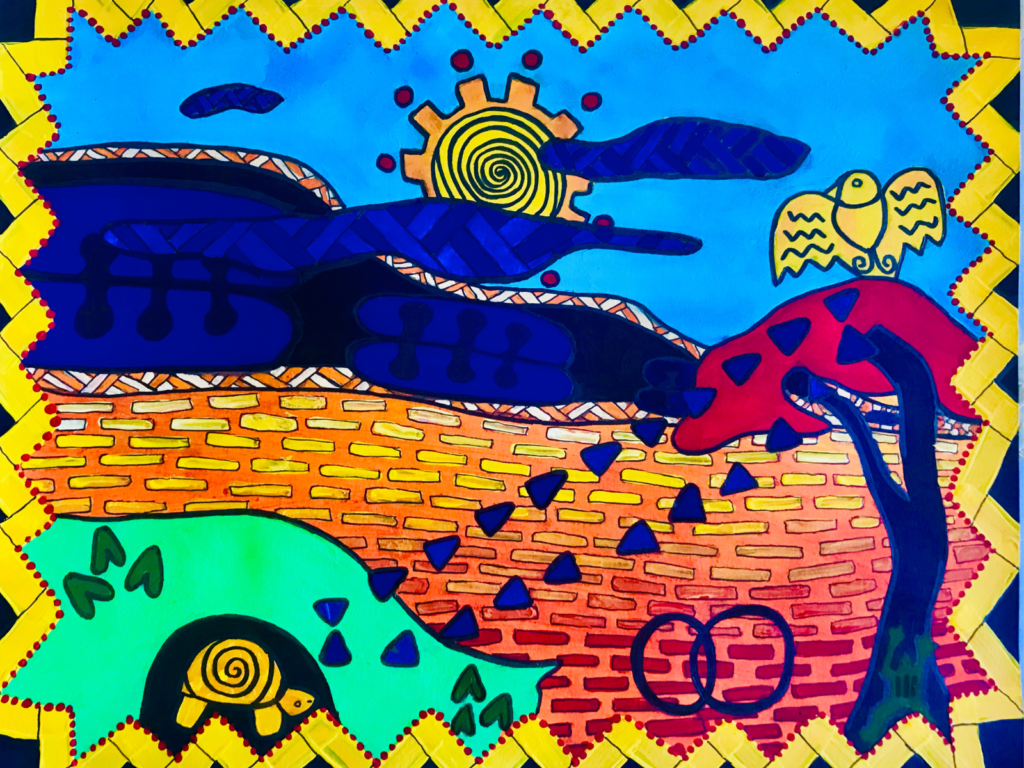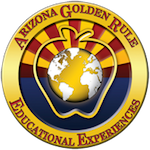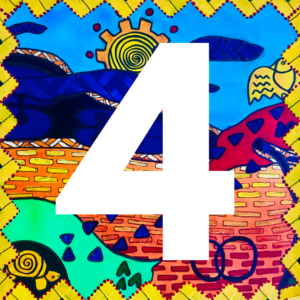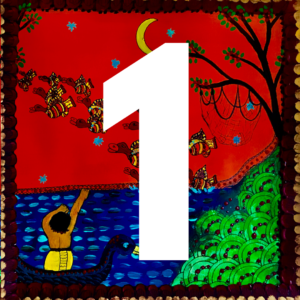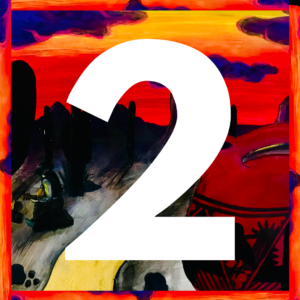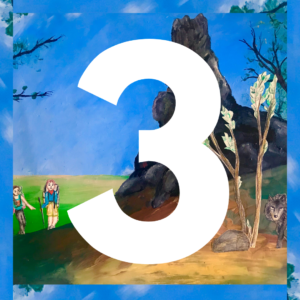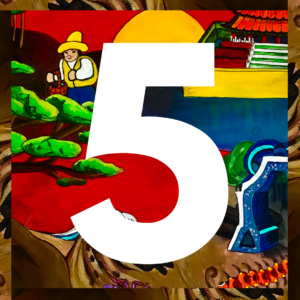“Stars Shine Brightly” is an arts resource, complete with world folk tales and original music, developed for grade levels K-5. Activities are for the classroom and include: Storytelling, Music, Dance, Theater, and Visual Art. “Stars Shine Brightly” is aligned with Arizona educational standards in ELA, World/Language, Arts; and Socio-Emotional competencies.

Fourth Grade Teacher Guides: Below are five sequential Fourth Grade cultural activities in Storytelling, Music, Theater, Dance, and Visual Art. Each activity begins with a group discussion (Prospecting for Gold) and ends with a class challenge (Golden Rule Challenge). As you use this resource in the classroom, your students will deepen their understanding of the Golden Rule, “Treating others the way they want to be treated,” through the life guiding principles of Kindness, Empathy, Respect, and Civility.
Arts Experience #1
Storytelling
AZ PO Strands
COM.N.1, 4.SP4.3, 3.SL.1
Golden Rule Focus
Students will learn about how to treat their friends when they are having a problem.
Objectives
Communities (COM.N.1) Recognize a few letters or characters and learned words and phrases.
Skills/Processes (4.SP4.3) Use evidence from multiple sources to develop and communicate claims about the causes and effects of events.
Speaking/Listening (3.SL.1) Participate in collaborative conversations with diverse partners and in small and larger groups. Follow agreed‐upon rules for discussions.
Materials
AGREE Resources:
AGREE Resources: “The Friendship of Tortoise and Eagle” Resource, “Anansi and Turtle” Resource, “Samahani” Audio Resource (on this page), “African Fables Venn Diagram” Visual Resource, Civil Discussion
Prospecting for Gold Consider rewarding students for their Golden Rule efforts by creating a jar for “gold nuggets” with a promised reward for filling it up.
BEFORE YOU BEGIN…
Establish Civil Discussion in your classroom. The Civil Discussion guide uses the Golden Rule as an agreed upon standard of conduct that can be used to discuss a variety of topics (aligned with AZ State standard 1.SL.1-1.SL.5). To begin each Art Experience, use Civil Discussion guidelines while holding class discussions (“Prospecting for Gold”).
Prospecting for Gold: What does it mean to ‘live’ the Golden Rule?
Golden Rule Activity Part 1:
- “It’s time for a Golden Rule Experience! (Prospecting for Gold) What does it mean to ‘live’ the Golden Rule?“
- “As a class, we will be exploring two different stories, each with a similar message about friendship. Each story originated from different regions within the continent of Africa.”
- Ask the following questions and have students give a thumbs up or thumbs down in response:
- Has your friend ever done anything that made you feel sad?
- Have you ever felt sorry for something you said or did to a friend?
- As a class, discuss and list problems students face in friendships (staying generic and avoiding names) and then list positive and negative ways they can respond to these problems.
- “When we have a problem, and have hurt someone’s feelings, we say ‘I’m sorry. Swahili is a language of Africa. In Swahili, ‘I’m sorry’ is ‘samahani’” Use “samahani” Audio Resource (on this page) for pronunciation. Invite your students to practice saying ‘samahani’ in pairs.
- Ask your students to share examples of when it is important to say “I’m sorry.” Discuss what to do when someone says sorry after hurting your feelings (e.g., show empathy, want to help your friend).
Telling the Story Part 1:
- “We will be reading “The Friendship of Tortoise and Eagle” from Central Africa. In this story, there are three animals: tortoise, eagle, and frog. For each character we will create a unique rhythm on our desks.”
- Help your students create a drum beat to represent each character.
- slow/steady rhythm for turtle
- fast/bouncy rhythm for frog
- long beat/short beat rhythm for eagle
- “While we read the story, quietly drum the rhythm of each character as we are hearing about them and their actions.” Practice the rhythms to solidify understanding of each animals’ unique sound.
- Read or listen to the story with students creating the rhythms for each of the animals. (“The Friendship of Tortoise and Eagle“)
Telling the Story Part 2:
- “We will now be reading a second story from West Africa. We will be comparing the events in this story to ‘The Friendship of Tortoise and Eagle.'”
- Select two students to act out the following characters in the story and invite them to stand in front of the class.
- Anansi the spider
- Turtle
- Explain that they will be acting out the story for the class as the story is read. Encourage them to respond to “acting cues” or words that trigger an action to be carried out at a certain time (e.g., picks up the rock, sits at the table).
- Read or listen to the story while students act out the tale “Anansi the Spider and the Turtle”.
Golden Rule Activity Part 2:
- “Both of our stories about friendship happened in different places, with different kinds of characters, but with similar outcomes.”
- Have students pair up and answer each of the following questions:
- What things in these stories were similar?
- What things in these stories were different?
- What evidence is there to show what makes or breaks a friendship?
- Print and distribute the African Fables Venn Diagram Print Resource to help them map out their ideas.
- Write the Golden Rule Challenge on the whiteboard or print to post and display it somewhere visible in the classroom. Read the Golden Rule Challenge as a class, “I will treat my friends with respect and when needed or as necessary, respectfully walk away.“
Golden Rule Challenge: I will treat my friends with respect and when needed or as necessary, respectfully walk away.
Arts Experience #2
Music
AZ PO Strands
4.MU.CN.11a, COM.N.1, 4.SL.1
Golden Rule Focus
Students will share their opinions with others and be willing to listen to others in return.
Objectives
Music Connecting (4.MU.CN.11a) Explore and describe relationships between music and other content areas.
Communities (COM.N.1) Recognize a few letters or characters and learned words and phrases.
Speaking/Listening (4.SL.1) Participate in collaborative conversations with diverse partners and in small and larger groups. Follow agreed‐upon rules for discussions.
Materials
AGREE Resources:
“That’s My Belief” Music Resources, “That’s My Belief” Lyrics Resource, “Hiyo ni imani yangu” Audio Resource (on this page)
Additional Material: Drum

Cultural Focus

Foreign Language Audio Resource: That’s My Belief
Prospecting for Gold: How have you treated your friends when they have not treated you well?
Golden Rule Activity:
- “It’s time for a Golden Rule Experience! (Prospecting for Gold) How have you treated your friends when they have not treated you well?”
- Review key details of the two stories, “The Friendship of Tortoise and Eagle” and “Anansi and the Turtle,” leading to the following two conclusions:
- Both turtles offered gestures of friendship and kindness (food, company, welcoming responses)
- Eagle and Anansi took advantage of that kindness (ate their food, offered nothing in return, made false promises)
- Pick one story (“The Friendship of Tortoise and Eagle” or “Anansi and the Turtle”) and use the Golden Rule Compass & Puzzle. Invite a student to step into the center of the compass as either Eagle or Anansi, and respond using the compass to the following actions of Tortoise/Turtle:
- They welcome you into their home
- They give you food
- They invite you to visit again
- Remind your students of the importance to treat others the way they would like to be treated, with Kindness, Empathy, Respect, and Civility.
Singing the Song:
- This is a call and response rhythm activity. “In Africa, the drum is central to many customs and daily norms. The drum can be compared to the heartbeat of a group.”
- “The song we will be learning is called ‘hiyo ni imani yangu’ which means ‘That’s My Belief’ in Swahili” (“Hiyo ni imani yangu” Audio Resource on this page for pronunciation). Have students practice saying ‘hiyo ni imani yangu’ with you.
- Have your students join you in making a steady, quiet, and unified rhythm by drumming on their desk. Once students are playing a unified, steady rhythm, have them continue quietly as you speak the lyrics to the song. Have them repeat back the words, call and response. Use “That’s My Belief” Lyrics Resource.
- Print or project lyrics on the board and play “That’s My Belief” from the beginning and invite them to sing along.
- As the song ends, begin to play a steady rhythm on your drum or hard surface, inviting your class to join in. Get quieter and quieter and once everyone is silent, say “breathe in” and then say “breathe out.”
- Ask the following questions:
- What happens when we stop listening to each other in music? (e.g., it becomes noise, can’t hear the beat/rhythm)
- What happens when we stop listening to each other in our friendships? (e.g., we don’t get to know each other, we stop feeling important)
- Why is listening part of living the Golden Rule? (e.g., I like when people listen to me thus, I need to listen in return)
- Write the Golden Rule Challenge on the whiteboard or print to post and display it somewhere visible in the classroom. Read the Golden Rule Challenge as a class, “I can speak but I must also be willing to listen.”
Golden Rule Challenge: I can speak but I must also be willing to listen.
Arts Experience #3
Theater
AZ PO Strands
TH.CR.1.4c, 4.RF.4, 4.SL.1
Golden Rule Focus
Students will discuss how to recognize body and facial expressions to help them know how others are feeling.
Objectives
Materials
Cultural Focus
Theater Creating (4.TH.CR.1c) Imagine how a character moves and speaks to support the story and given circumstances in a theatrical work.
Reading Fluency (4.RF.4) Read with sufficient accuracy and fluency to support comprehension.
Speaking/Listening (4.SL.1) Participate in collaborative conversations with diverse partners and in small and larger groups. Follow agreed‐upon rules for discussions.
AGREE Resources:

Prospecting for Gold: Does listening take practice? Why would we want to practice our listening skills?
Reading the Script:
- “It’s time for a Golden Rule Experience! (Prospecting for Gold) Does listening take practice? Why would we want to practice our listening skills?
- “Today we will be acting and reading a script. We will begin by playing a game of charades.” Select 3 students to act like the following animals/things, while the rest of the class guesses:
- A turtle
- A frog
- A tree
- Ask your class to share what the acting students did with their bodies to help show which animal they were (e.g., crawled, hopped, wiggled, facial expressions).
- “You can also use your body to act out things in nature.” Invite your class to stand and act out the following things:
- Water
- Sunshine
- Happiness
- Divide your class into groups of four and give each group a printed version of “Eagle’s Big Mistake”. Have each member of the group chose a character:
- Mr. Tortoise
- Frog
- Mrs. Tortoise
- Eagle
- Encourage the groups to read slowly and with expression. Invite them to use Kindness to help each other if they need any assistance reading certain words or raise their hand.
Golden Rule Activity:
- “Our bodies can communicate feelings and thoughts through facial expressions, vocal sounds and body movements. By paying attention to others, we can understand how they might be feeling. This helps us develop Empathy.”
- “Now we will play another game of charades but this time we are trying to recognize emotions.” Select three students to act out the following emotions, while the rest of the class guesses:
- Happiness
- Sadness
- Scared
- Excited
- Discuss the following questions about boundaries with your class:
- What did you observe about their body and facial expressions?
- What did their actions tell you about how they wanted to be treated?
- Would their response change if it was a family member? How?
- What can we focus on to recognize other people’s boundaries and their levels of comfort?
- Write the Golden Rule Challenge on the whiteboard or print to post and display it somewhere visible in the classroom. Read the Golden Rule Challenge as a class, “I will pay attention to other people’s actions and try to understand how they might feel.”
Golden Rule Challenge: I will pay attention to other people’s actions and try to understand how they might feel.
Arts Experience #4
Dance
AZ PO Strands
4.DA.CR.1c, 4.SL.1, COM.N.1
Golden Rule Focus
Students will practice working together with different members of a group.
Objectives
Dance Creating (4.DA.CR.1c) Experiment with a variety of self-identified stimuli and build content for choreography using several stimuli (e.g., music/sound, text)
Speaking/Listening (4.SL.1) Participate in collaborative conversations with diverse partners and in small and larger groups. Follow agreed‐upon rules for discussions.
Communities (COM.N.1) Recognize a few letters or characters and learned words and phrases.
Materials
AGREE Resources:
“Mchezo wa Furaha” Audio Resource (on this page), “That’s My Belief” Music Resource, “Mchezo wa Furaha” Dance Video Resource, “That’s My Belief” Lyrics Resource
Cultural Focus

Foreign Language Audio Resource
Prospecting for Gold: How can you help others feel safe around you?
Doing the Dance:
- “It’s time for a Golden Rule Experience! (Prospecting for Gold) How can you help others feel safe around you?”
- “Dancing is a way to bring people together and experience happiness through movement. The dances of Africa include earthy movements that use hands and legs to imitate things in nature. You are going to create your own dance and we will call it “Mchezo wa Furaha” meaning a dance of happiness in Swahili (“Mchezo wa Furaha” Audio Resource on this page).
- Split into six groups and assign the following lines to each group, to create a movement or simple choreography:
- “Give and I’ll give back to you”
- “I give you may give back to me too”
- “But no matter how you choose to be, I will be happy”
- “I may not talk loud in the crowd”
- “You may come around to bring me down”
- “But no matter how you choose to be, I will be happy”
- Play “That’s My Belief” Music and have each group perform their movement(s). During the chorus, invite them to move to the music.
- As a class, create choreography to the chorus. One way to do this is to:
- Read the lyrics and invite students improvise or make-up movements to the music.
- Work together as a class to create choreography, picking movements improvised by your students.
- The chorus lyrics are:
- “We’ve got sun shining on our faces, We’ve got beauty and open spaces, Mother Earth she holds us up no matter what. And everyday when I walk these places, I can see me in all your faces. Happiness begins in me, and that’s my belief.”
- Practice your class choreography and when you are ready, play the song and perform the movements with the music. Watch “Mchezo wa Furaha” Dance Video Resource for an example of movements.
Golden Rule Activity:
- Discuss the following questions:
- How do we feel when we are dancing together “peacefully”?
- How is “dancing together” similar to how we interact in our classroom and at home?
- How can we find joy in spending time together in our classroom?
- Write the Golden Rule Challenge on the whiteboard or print to post and display it somewhere visible in the classroom. Read the Golden Rule Challenge as a class, “I will find ways to enjoy interacting with all members of a group.“
Golden Rule Challenge: I will find ways to enjoy interacting with all members of a group.
Arts Experience #5
Visual Art
AZ PO Strands
4.VA.CN.10a, 4.RL.7, 4.SL.1
Golden Rule Focus
Students will identify character traits that are helpful in the classroom.
Objectives
Visual Art Connecting (4.VA.CN.10a) Create a work of art that reflects community or cultural traditions.
Reading literature (4.RL.7) Make connections between the text of a story or drama and a visual or oral presentation of the text, identifying where each version reflects specific descriptions and directions in the text.
Speaking/Listening (4.SL.1) Participate in collaborative conversations with diverse partners and in small and larger groups. Follow agreed‐upon rules for discussions.
Materials
AGREE Resources:
“Turtle Template” Visual Resource, “West African Symbols” Visual Resource, “Africa Symbols Teacher Guide” Visual Resource
Additional Materials: Crayons, scissors, brown paper bags
Cultural Focus

Prospecting for Gold: What are ways we can enjoy spending time together as a class? How can we express interest in each member?
Golden Rule Activity:
- “It’s time for a Golden Rule Experience! (Prospecting for Gold) What are ways we can enjoy spending time together as a class? How can we express interest in each member?
- “Each character in our stories had a role to play. Just like in a story, each person in our classroom has a part to play. Sometimes we act in different ways at different times, just like the characters in our stories acted in different ways at different times.”
- Distribute the West African symbols (“West African Symbols” Worksheet Resource) to each student. Project and look at each symbol with your students and have them write down what they think each of the symbols mean.
- “We will be using these symbols from West Africa to describe the actions of the characters in our two stories.” To complete the worksheet:
- Have students select a character from one of the stories and write it on their “West African Symbols” worksheet.
- Invite them to circle the symbols that describe the character they chose.
- Have students write 1-2 sentences about why they chose those symbols to represent their character on the “West African Symbols” worksheet.
Creating the Art
- Print and distribute “Turtle Template” Visual Resource and paper bags to your students. Follow the steps below:
- STEP 1: Have students cut out the turtle shape from the “Turtle Template” and trace it onto their brown bag, with the shell divided diagonally.
- STEP 2: Of the symbols students selected, have them identify which symbols are positive and which are negative.
- STEP 3: Using earth tone markers (red, black, yellow and white) have students copy the symbols they chose onto their turtle.
- STEP 4: When finished, lightly wet the paper and crumble it to give it a rustic, weathered look.
- “Every person has positive and negative traits. Every day is like a dance of deciding how we will act out those traits.” Write the Golden Rule Challenge on the whiteboard or print to post and display it somewhere visible in the classroom. Read the Golden Rule Challenge as a class, “I have an important part to play in my class and I will try to be helpful with my actions.”
Golden Rule Challenge: I have an important part to play in my class and I will try to be helpful with my actions.
Bulletin Board Idea: Create a bulletin board with bright colors and bold shapes around the border. Make a large “class turtle” and place it in the center of the bulletin board. Display the turtles your students created around the “class turtle” on the bulletin board. As a class, when you see students demonstrating a positive attribute from the African Symbols page (or create your own), draw that symbol on the “class turtle.” This can be used to encourage helpful actions in your classroom.
